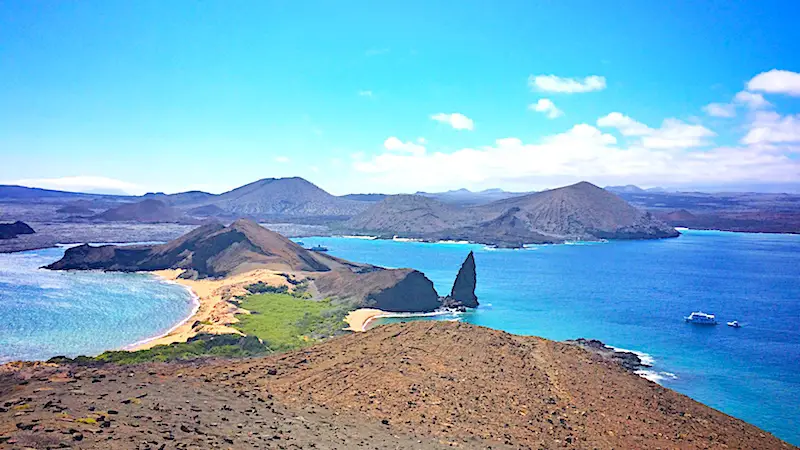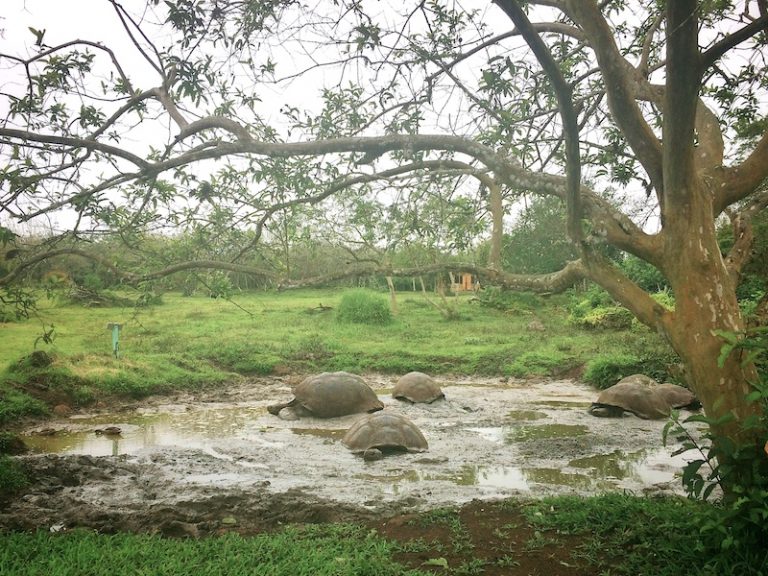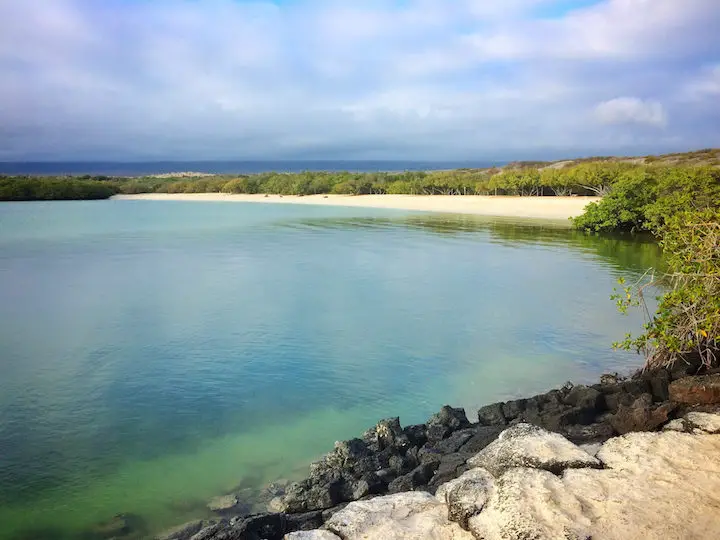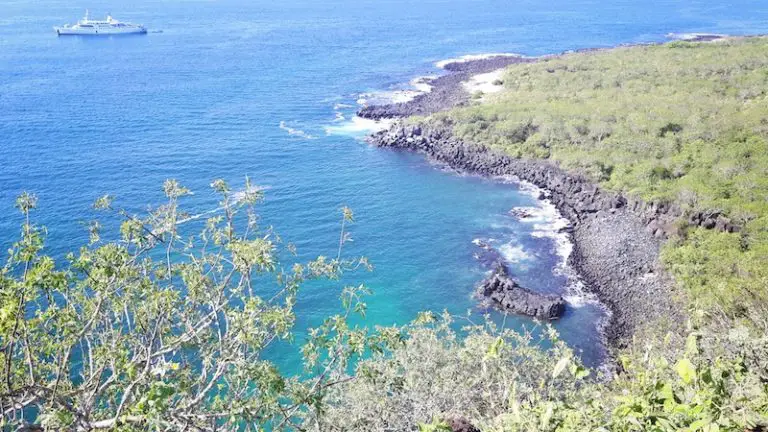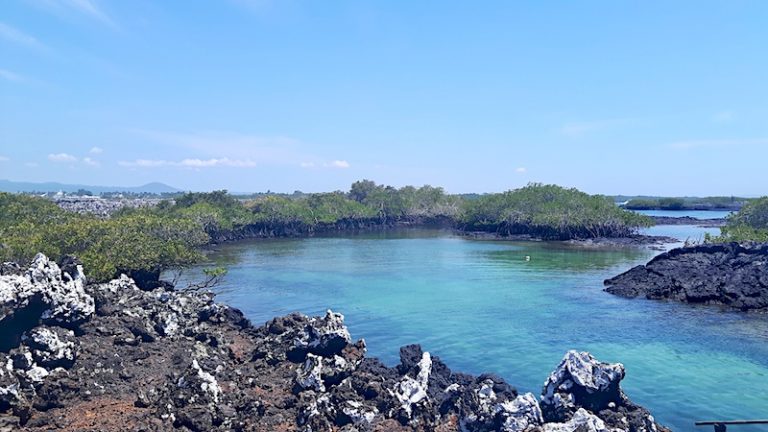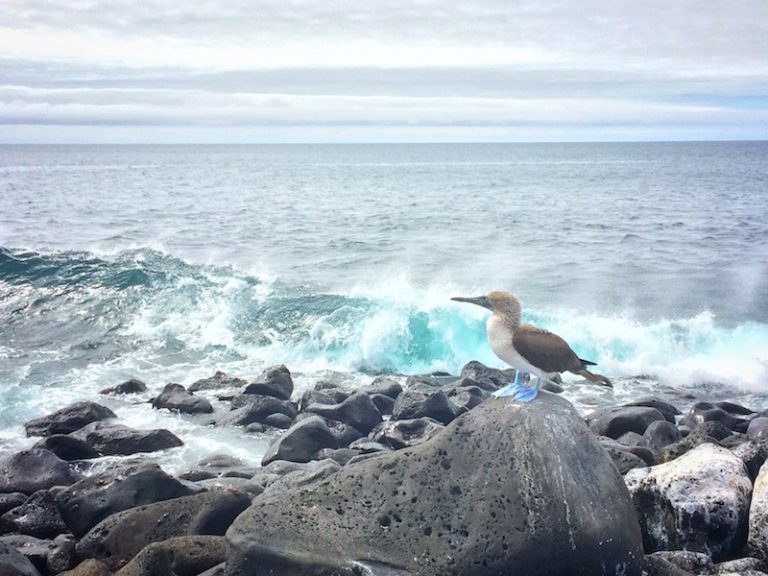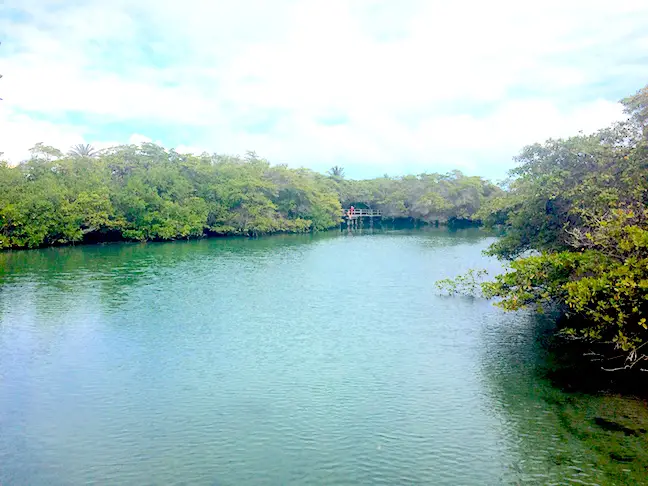The Ultimate Guide to Land-Based Galapagos Islands Travel in 2019
Some links in this post may be affiliate links. If you click on them we may make a commission from qualifying purchases at absolutely no cost to you. Read our full Disclosure Policy here.
Traveling to the Galapagos Islands is a bucket list item for most people and one that takes some planning to make the most of every magical second. This ultimate Galapagos Islands travel guide is designed to do a lot of that work for you. Consider this your one-stop-shop for planning a trip to the Galapagos Islands!
Quite honestly, I’d never given much thought to visiting the Galapagos, imagining a place that could only be reached on a very expensive cruise. One I’d never be able to afford.
While those cruises are definitely the most common means to see the islands, land-based Galapagos travel is surprisingly easy and the perfect way to travel to Galapagos on a budget. We also got to do exactly what we wanted, when we wanted.
An additional bonus is that spending time on the islands, staying and eating locally puts money in local pockets rather than some large tourism company!
Here is a breakdown of everything you can find in this colossal guide (there’s a LOT):
[space_20]
Want to learn more about travel to the Galapagos Islands? For more detailed information on how to plan a trip to the Galapagos Islands without a cruise, get our Perfect Galapagos Packing List and read our detailed island and activity guides below:
- 16 Amazing Things to do in Santa Cruz (mostly free)!
- 17 Unforgettable Things to do in San Cristobal.
- 11 Reasons you should visit Isla Isabela.
Does vacation planning make your head spin? We’ve got you a covered with a ready-to-book two-week Land-Based Itinerary.
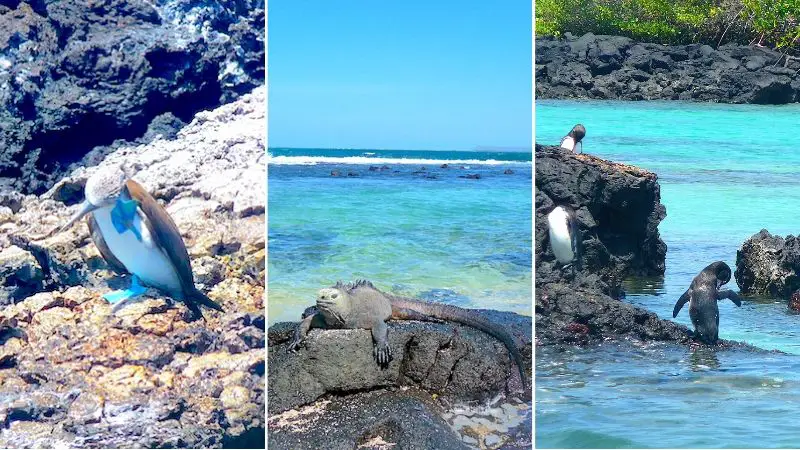
[space_20]
The Complete Galapagos Travel Guide
Cruise vs. Land-Based Galapagos Tours vs. Independent Travel
Probably your first decision to make when planning your trip to the Galapagos Islands is if you want to book an organized Galapagos tour or plan your own independent travel. There are advantages and disadvantages to both.
Galapagos Cruises or Organized Tours: There are 3 main ways to explore the Galapagos Islands in an organized group.
- Live-aboard dive boats are the ultimate experience for serious SCUBA divers but are also one of the most expensive ways to explore the Galapagos.
- Traditional cruises staying on a cruise ship (much smaller than anything you’d see cruising the Caribbean) and making various stops each day around the islands. The prices vary wildly depending on the length of cruise and level of luxury but are still one of the more expensive options. Much of the Galapagos National Park cannot be reached by day trip from the towns so this is the best way to see some of the more remote locations.
- Galapagos Land-Based Tours provide a naturalist guide for pre-organized daily tours and hotel accommodations are included. Seeing the Galapagos without a cruise is a great option for those who want to save money, or don’t like the idea of being on a boat all the time (a particularly great option if you’re prone to motion sickness) but still want to have a guide.
Galapagos Independent Travel: It is possible to save a lot of money by travelling to the Galapagos on your own. However, besides budget, it is also a great option for people who simply prefer not to be in a group with all their activities planned for them. This option provides the maximum flexibility and freedom to choose EXACTLY the activities that interest you.
If you prefer to book an organized multi-day tour, some of the best tour itineraries we could find include:
- Galapagos Harmony (7 days) – includes Santa Cruz, Santa Fe, Isabela and Seymour islands.
- Galapagos Bike and SUP (7 days) – an adventure-packed tour including Santa Cruz and San Cristobal islands.
- 5-Day Galapagos Multi-Sport – incorporates hiking, biking and kayaking on Santa Cruz and Isabela islands.
You should also check out G Adventures Galapagos Tours. People love their tours and they make giving back to local communities a focus. A number of their tours also combine time on mainland Ecuador or even Peru and Colombia!
Frequently Asked Questions
Do you have lots of questions about the islands? We did, and they weren’t at all how we imagined in many ways. To get started here are some questions we had about the Galapagos Islands:
- Where are the Galapagos Islands? The volcanic archipelago is located about 1000km west of the coast of Mainland Ecuador and do actually belong to Ecuador.
- Are the Galapagos Islands Safe? Yes. The islands are small and not particularly urbanized. The animal population far outweighs the humans. The number of inhabitants is carefully controlled and the economy is supported largely by tourism so they have a vested interest in keeping visitors happy. Common sense is still important but we never felt even slightly uncomfortable.
- When is the Best Time to Visit the Galapagos Islands? The short answer is anytime. Straddling the equator, the Galapagos Islands weather is always warm. There are two distinct seasons, however, and different months are better for some animals than others. If there is something you particularly want to see, plan accordingly. Otherwise, you won’t be disappointed any time you choose to go. More details below.
- What is there to do in the Galapagos Islands? So much! Aside from goggling at sea lions and marine iguanas on land, choose from snorkelling with sharks and turtles, hiking up volcanoes, learning to surf and crawling through lava tunnels. The list is endless! Check out our guides for each island for specific activities.
- What should I Pack for Galapagos Travel? The Galapagos Islands are filled with adventure and extremely remote. Carefully packing the right clothes and equipment will make a big difference to your enjoyment level. Use our Essential Galapagos Packing List to get it just right.
- What Time Zone are the Galapagos Islands in? Being such a special place, they get their own time zone so they are on Galapagos Time. But what does that mean? Ecuador is technically in the Eastern Standard time zone, that is GMT-5, but the Galapagos Islands are one hour behind mainland Ecuador (GMT-6). However, given their geographic location, they do not observe Daylight Savings Time. This means that from March to November, the islands are on Mountain Time along with cities such as Alberta and Colorado. From November to March, the Galapagos Islands are on Central time along with cities such as Manitoba and Illinois.
- How much will a Galapagos Trip Cost? That entirely depends on if you choose a cruise or independent travel, 2-star or 5-star accommodations and fine dining or street food. However, we travelled the Galapagos by land for 11 days and spent around $1100 USD per person including every penny we spent from our flights to and from Guayaquil to souvenirs.
Useful Facts about the Galapagos Islands
Here are a few facts to help you prepare for this once-in-a-lifetime trip:
- Electrical outlets: Ecuador, and the Galapagos, use North American electrical outlets.
- Currency: The official currency in the Galapagos is the US Dollar. However, they do have their own coins that can’t be spent in the United States. Ecuador is still largely a cash society and larger bills can be really difficult to break. As Canadians, our Tangerine bank account caps all transaction fees at a max of $2, saving us a lot of money. Use the referral code: 54708228S1 to get a bonus $50 when you sign up.
- Language: The official language is Spanish (while most people working in tourism speak some English, a little Spanish will go a long way).
- The tap water is not safe to drink – but every place we stayed had free drinking water available. We also used it to brush our teeth with no issues but that’s a personal choice.

READ THIS POST:
The Top 9 Things to do in Quito, Ecuador.
Less Useful (but Interesting) Facts
While the following may not help you prepare, they just might help increase your excitement level (if that’s possible):
- The Galapagos Islands are named for the shell of the giant tortoise, coming from the old Castellan word for saddle.
- In 1978, the Galapagos Islands were named the first UNESCO World Heritage Site which allows for strict controls to help preserve it.
- 97% of the islands are designated as National Park and cannot be inhabited. Many islands cannot be stepped on at all.
- The population of the Galapagos Islands is 30,000 (who knew?).
- Half of all land species (and one-fifth of marine species) found in the Galapagos Islands are endemic.
- Four ocean currents converge in the Galapagos bringing nutrient-rich water and an abundance of marine life.
- The Galapagos Islands are the only place in the world penguins live in the Northern Hemisphere and lizards can swim!
- Animals in the Galapagos have very little fear of humans. It’s important to follow the rules and stay at least 2m away. They, pay no attention to this rule, however, so you may find yourself having to back up!
Responsible Travel Tips
- Bring a reusable water bottle that you can refill each day.
- Pack a reusable shopping bag that packs flat. I always bring a canvas drawstring bag. It takes up no room and I can use it for groceries, wet swimsuits or dirty laundry.
- If you really need a straw in that delicious maracuyá mojito (it’s a thing and you need to try it), bring a stainless steel straw with you.
- It may be in the middle of the ocean, but freshwater is a major problem in the Galapagos. Don’t waste it! Take short showers and turn off the tap while brushing your teeth.
- Be flexible. The islands are about as remote as it gets so when something is gone, it may be gone for a while. Embrace it as part of the experience and just order an alternative.
- Make sure you pack reef-safe sunscreen to minimize your impact on coral reefs and marine life.
- DO NOT touch the wildlife! Follow all park rules and respect their home. We saw some idiot stroke a sea lion pup for a picture. It is very likely that its mother rejected it after that. Not worth a picture. Stay 2 metres away and don’t use a flash.
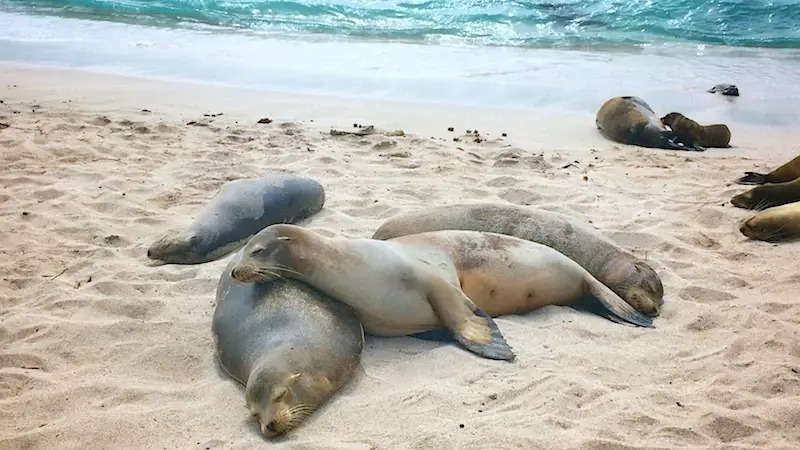
[space_20]
Guide to the Galapagos Islands by Land
Land-Based Galapagos Independent Travel
Booking a tour or cruise means that just about everything will be planned for you so this Galapagos travel guide will focus on travelling independently. Of course, if you are on a cruise we highly recommend planning a few extra days before or after your cruise to explore independently. We cannot say enough about how incredible it is to see the Galapagos by land.
Galapagos Islands Entry Requirements
The following requirements are mandated by law:
- Identification (passport)
- Proof of a return flight
- A reservation with a hotel or cruise
- Travel Health Insurance – we use, and love, World Nomads.
NOTE: These requirements were new in 2018 and are not yet being fully enforced – we were only asked for our return flight information – however, there is no way of knowing when they will begin requiring for the details.
In addition, you will need to purchase a Transit Control Card for $20 before checking in for flight. When you land in Baltra or San Cristobal, the information on the card will be checked and you will pay an additional $100 ($50 for children and residents) for a Galapagos National Park entry fee.
How to get to the Galapagos Islands
Getting to Galapagos is an adventure in itself and only possible by flying from either Quito or Guayaquil. Flights leave from Quito and Guayaquil to either Baltra Airport (GPS) or San Cristobal Airport (SCY). Many Quito flights, however, make a stop in Guayaquil so check that it’s direct before booking. National airlines LATAM, TAME and Avianca fly these routes daily. It is currently impossible to fly directly to the Galapagos Islands from any international destinations.
We booked with TAME both times, finding tickets between $250 and $350 and had good experiences. Check the price carefully as some airlines offer steep discounts for Ecuadorian citizens and military. That ‘too-good-to-be-true’ deal might mean a hefty charge at the airport if you paid the wrong fare!
Arrive at the airport early. Despite being a national flight, there are extra security inspections for Galapagos departures which can take some time. We gave ourselves two to two and a half hours each time which was plenty.
You need to get a Transit Control Card and have your bags inspected BEFORE CHECK IN. In Guayaquil, there are designated desks around the middle of the row of check-in booths. I assume it is similar in Quito.
Present your flight information and passport to the person in the window. After checking your travel details and identification, you will be required to pay $20 and receive a Transit Control Card. Keep this safe as you will need to show it when you leave the Galapagos Islands.
Following this, you will move to the next line (on your immediate right in Guayaquil) and have your luggage scanned, checked and tagged for anything on the restricted list. Now you are ready to check in for your flight.
We highly recommend flying into one airport and out of the other to maximize time on the islands. If at all possible, fly into Baltra and out of Santa Cruz. While the hour journey to from Santa Cruz airport to Puerto Ayora is well-organized with public transportation as flights arrive, you will more than likely have to spring for an expensive taxi ride to the Itabaca Channel for your return flight. San Cristobal airport is easily accessible from town.
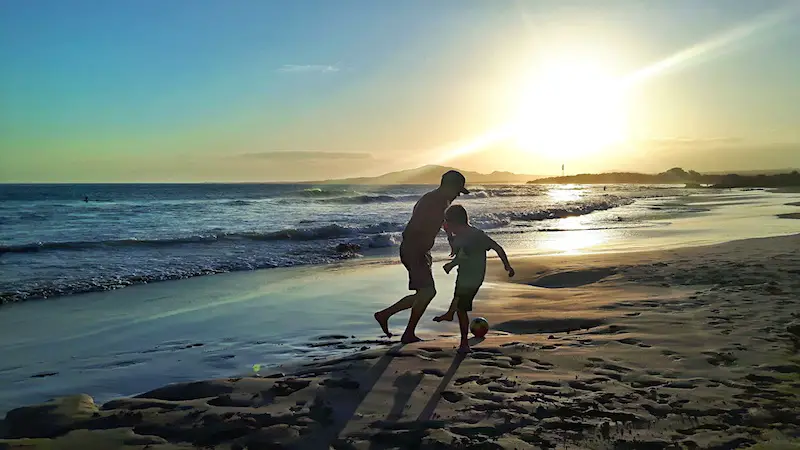
How to get around the Galapagos Islands
It is really easy to get around the islands once you have arrived although the lack of information online can make it seem daunting. As you move between each island, you will pass through a security check where your bags and shoes will be inspected. This is to prevent any live matter being transported between islands and disrupting the ecosystem.
Ferries: To get between the four inhabited islands, Santa Cruz, San Cristobal, Isabela and Floreana, there are daily speedboat ferries. Morning and afternoon sailings leave for each island except Floreana – for that there is only one time. Routes all run to and from Santa Cruz to each of the other islands. You should buy your tickets at least a day or two in advance. All ferries take approximately 2 hours and cost $25-30.
Keep small change handy. At the start and end of each ferry, you will be transported by water taxi to and from the boat. This isn’t included in the ferry ticket so you will need to pay in cash on the small boat. It is usually 50¢ in San Cristobal and Santa Cruz but $1 in Isabela.
Flights: There are small puddle jumpers that run inter-island daily flights. Obviously, these cost a lot more than the ferries but are quicker and a preferred choice for some. You’ll also get some of the most incredible views over the islands during your flight. Check out Emetebe’s website for online bookings. Flights will cost around $190 per passenger.
Taxis: Each island has plenty of taxis in the form of white pick-up trucks (grey on Isla Isabela). In town, one can easily be found and accommodations will also be able to call and book one for you. Out of town is a different story. If you take a taxi to a remote location, be sure to agree on a price to wait or a return time to make sure you can get home!
Bike rentals: Each island has plenty of bike rentals available. Most will cost around $15 a day. Santa Cruz and San Cristobal Islands had well-maintained cycle paths running alongside the main road into the highlands which is perfect to explore. Isabela doesn’t, but given its quiet sandy streets, it really doesn’t need one either! Keep in mind that if you plan to cycle into the highlands, be ready for some hills.
The Best Time to visit the Galapagos Islands
There is no bad time to visit. Straddling the equator, the islands are blessed with year-round warm temperatures and 12 hours of sunlight every day. However, there are a few things to keep in mind when choosing when to go.
January to June is the warm, wet season (relatively – we saw no rain in April). The islands transform into a lush, tropical green landscape, are more humid and the water is warmer. If you are prone to seasickness, the waters are also much calmer during these months.
July to December is the cool(er), dry season. As the months progress, the island dries out and becomes more barren. The ocean is also noticeably colder. While less comfortable, the cooler ocean currents bring nutrients that make it a great time for diving.
Each animal has its own optimal season. If there is something you are really interested in seeing, make sure your visit coincides with the right time of year. For example, in December we saw baby sea lions and the albatross are on Española Island. In April there were baby sharks everywhere and marine iguanas were nesting.
What to Pack for the Galapagos
We wrote up a complete packing list for the Galapagos Islands that will give a lot more detail but here are a few things that we can’t recommend enough:
Reef safe sunscreen: Despite a near constant breeze making temperatures comfortable, the Galapagos Islands are on the equator so the sun is at its most powerful. A good sunscreen is essential and, given the amount of snorkelling you will be doing, it really should be reef safe to protect the fragile ecosystems.
Sunhat {his and hers}: Keeping your head protected from the sun is infinitely better than trying to remember to reapply sunscreen every time you sweat or swim.
GoPro: There will be so many incredible underwater experiences that you’ll regret not having a waterproof action camera.
Dry bag: You are going to be on and off boats for your entire trip as well as spending time at beaches and docks. Keep valuables safe and dry with a dry bag.
Travel Towel: In case this isn’t obvious by now, you’ll be in the water. A lot. Accommodations won’t provide beach towels and some may not even provide shower towels. A microfibre travel towel takes us very little space, is super absorbent and is resistant to getting stinky. We don’t go anywhere without our beach size ones.
Waterproof sandals {his and hers}: A good pair of Tevas or Keens will protect your feet from the sharp lava rocks and coral in the water and be perfect for easy hikes and walks about town.
Snorkel: While you can rent, and most tours will provide equipment, it is always a better experience with your own gear. Of course, it will save money too.
Swimsuit: Take two sets as there is nothing worse than the feeling of putting on a wet bathing suit!
Reusable water bottle: Every accommodation we stayed in had free, unlimited drinking water available. Additionally, the Galapagos Islands have recently banned the introduction of single-use plastics. Do your part, and save money, by having a refillable bottle with you.
Basic First Aid Kit: Add some Dramamine for seasickness (common here) and Imodium for the dreaded traveller’s diarrhea along with the standard alcohol pads and Band-Aids.
Good quality camera with a zoom: I usually use my phone but this was one of a short list of places I regretted not having a camera with a decent zoom.
[btn text=”Get the perfect Galapagos Packing List now!” tcolor=#FFF bcolor=#fa7268 thovercolor=#FFF link=”https://pastthepotholes.com/galapagos-packing-list” target=”_blank”]
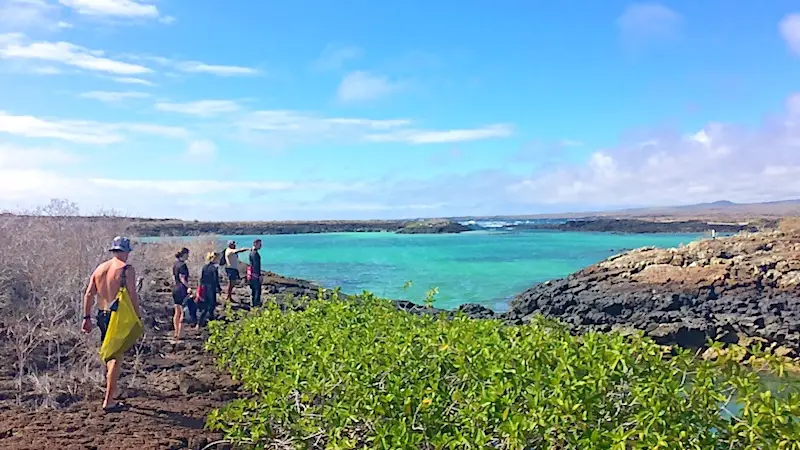
[space_20]
Galapagos on a Budget
A big part of exploring the Galapagos Islands on a budget means not overpaying for excursions or accommodations. In a place that runs on tourism, it is not uncommon for the same items to be offered at vastly different prices.
On our Bartolome day tour, we discovered that almost everyone had paid a different price. We were really happy to know that we had got the best price! We met a guy in Santa Cruz who had booked a last minute cruise and paid a third of what most of his fellow cruisers had been charged.
How to Save Money on Galapagos Day Tours and Cruises
Booking a Cruise Last Minute: If you aren’t too picky about what you see, wait until you get to Puerto Ayora in Santa Cruz Island to find a great Galapagos last minute cruise deal. Every tour operator in town will have a whiteboard displaying the cruises they have available, usually leaving the next day, and the discounted price. These prices can usually be negotiated further.
The Best Way to Book Day Tours: Day tours are the same. We waited until the night before to book most of our Galapagos day tours and were able to bargain down the price. No one wants empty seats on their boats! However, there are exceptions. On our second visit, as a group of 5 wanting to do the most popular tour in Isabela, Los Tuneles, they were sold out for the next 3 days. If you are a large group or have a specific (and popular) tour that you really want to do booking ahead might not be the best deal, but could be your best option.
How to Get the Best Price for Accommodation
Accommodations range budget to unimaginable. In order to get the best deal, we found that Booking.com had the best budget options. I always check Hotels.com first as for every 10 nights you book, they give you a free night. However, I just didn’t find too many good budget options on there for the Galapagos Islands. We’ve listed some of our recommendations below.
I search for the location and dates then put filters for anything we want. We prefer private bathrooms, double beds and review scores of 8+. I also select wifi but, honestly, the wifi is so terrible outside of Santa Cruz (where it is horrendously slow but functional) that it probably isn’t worth using this as a criterion. We bought local SIM cards on the mainland for $5 and found the data to be better than the internet when we needed it.
High season tends to follow school breaks. If you travel during off-peak times (there really isn’t a ‘low’ season in the Galapagos) you might find a better deal by booking your first one or two nights only. After you arrive, wander the town and ask in person for their availability and best rates. However, be careful that you don’t spend too much precious time looking for a bed instead of exploring the islands.
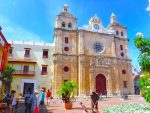
READ THIS POST:
The Perfect 3-Week itinerary for backpacking around Colombia.
How to Save Money on Food in the Galapagos
Book accommodations that include a kitchen. It can be fun to explore the local grocery stores and see what you can find. We found meat to be anywhere from very expensive to unappetizing and a little sketchy. Gourmet meals were not on the cards but pasta and sauce, hot dogs, salads, stirfry and such are easy to put together with local vegetables and grains.
Get breakfast and lunch at the grocery store. It is very rare that we enter a restaurant more than once a day. Typically, we will grab a piece of fruit and a bakery item or two from the store before we head out for the day.
Go to restaurants away from the waterfront. In Santa Cruz we recommend going to Charles Binford street at night, nicknames Los Kioskos, as the street fills with tables and chairs while restaurants try to tempt you to sit at their table with fresh seafood and great deals. In San Cristobal, there are a number of smaller local places on the side streets and many restaurants that will offer a set menu meal for $5-7. Isla Isabela is sorely lacking in choice but the main street has a row of restaurants that offer variations of menu del días for $8.
Bring food from the mainland or home. We usually travel with a few protein bars for hikes. However, food is not only expensive in the Galapagos Islands, but many items are hard to find at all. The rules are very strict about what can be brought in and, as a general rule, fruits, vegetables and seeds are forbidden. Most packaged and processed food are fine. We brought chickpeas, quinoa, peanut butter and jam without issue. Check the complete list here.

[space_20]
Galapagos Guide by Island
There are four inhabited islands, although only three of those see any sizeable traffic. Each one offers a unique experience so the more you are able to fit into your itinerary, the better. If you can’t fit them all, deciding which ones to skip can be a challenge though!
Which is the Best Island in the Galapagos?
Now that’s an impossible question if ever there was one! Each island is so unique that if you can fit them all in your Galapagos itinerary you really should. However, if you can’t or don’t want to move around the islands, you should choose depending on your main priorities. To try to help, here are some of our opinions:
Best Galapagos Island for Sea Lions: Without a doubt, San Cristobal Island is the best island to visit if you want to see as many sea lions as possible. However, every island we visited had plenty of sea lions so don’t panic if it doesn’t work out.
Best Galapagos Island for Penguins: If Galapagos penguins are top of your lists (and why wouldn’t they be?), you are going to want to get to Isla Isabela. If you just don’t have the time (it is the least convenient island of the main three) consider the Bartolome day tour from Santa Cruz. This is your best chance to see penguins otherwise. Unfortunately, we didn’t get lucky but the group the day before ours did.
Best Galapagos Island for Food and Nightlife: Santa Cruz Island has by far the best selection of bars and restaurants as well as the widest variety. San Cristobal comes in second.
Best Galapagos Island for Luxury Accommodations: San Cristobal seemed, to us, to have a classier feel with some really nice hotels along the waterfront. Santa Cruz feels like more of a backpacker spot BUT it has the lion’s share of Galapagos accommodation options so you could absolutely find luxury there.
Best Galapagos Island for Independent Free Activities: Isla Santa Cruz comes out on top here with a variety of free things to do right in, or a short walk or ferry ride, from town. San Cristobal comes a pretty close second though.
Best Galapagos Island for Budget: Santa Cruz has to win here again. Between the higher number of budget accommodations, cheaper food options and free activities, there is plenty to do without spending very much. There are also many day tours that leave from Puerto Ayora and with more competition, there is a greater chance of getting a deal on the price.
Best Galapagos Island for Beaches: Tough one! Our favourite is probably Tortuga Bay on Santa Cruz. However, Isla Isabela has its own stunning beach that doesn’t require an hour hike to reach it. San Cristobal has a large number of incredible beaches but many can only be reached by boat. Those in town are covered in too many sea lions to use them!
Guide to Santa Cruz Island
Santa Cruz is the hub of tourism in the Galapagos islands. Puerto Ayora is the largest town in the Galapagos and is surprisingly urbanized. This is a great base for independent travellers as there is the greatest number of accommodations, free and independent activities and options for booking day tours.
It is also the island with the most conveniences. There is a decent grocery store, a hospital and, for divers, the only hyperbaric chamber in the Galapagos.
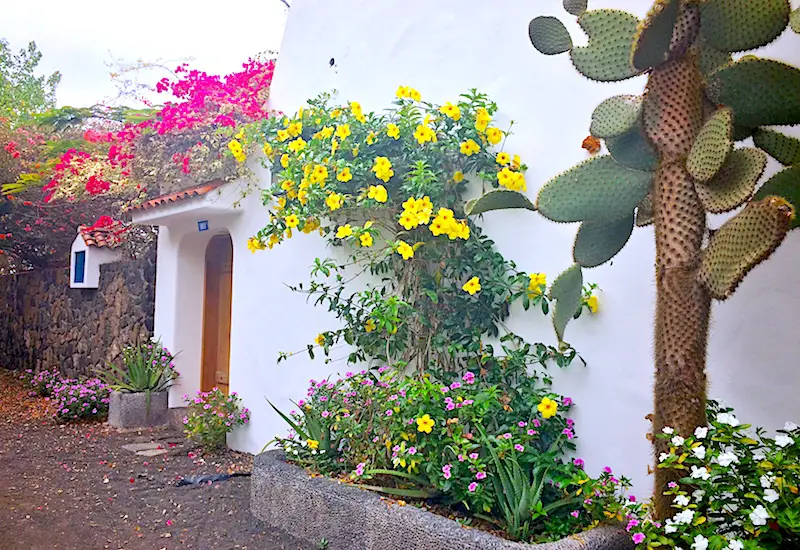
How to Get to Isla Santa Cruz
Most people fly into Baltra Airport. From here, you take a shuttle bus costing $5 (it was free until 2019), then a $1 ferry across the very narrow Itabaca Canal. Once on Santa Cruz Island, you can choose a $5 bus ride to the main town of Puerto Ayora or a $25 taxi ride (white pick-up trucks). It sounds complicated but they know the flight schedules and will be waiting at each spot. Just follow the crowd.
Coming from either Isla Isabela or San Cristobal to Santa Cruz, you will take one of the 2-hour speedboat ferries that run twice a day. Ferries depart from Isabela to Santa Cruz at 6am and 2pm. Ferries depart from San Cristobal to Santa Cruz at 7am and 3pm.
The Best Activities in Santa Cruz
Read our detailed Santa Cruz Island Guide as well as individual posts for each activity for more information. However, here is a quick snapshot of our favourite activities:
- Tortuga Bay: A seriously beautiful beach at the end of a hike through a cactus field. There is the main beach for surfing and a protected lagoon for snorkelling as well as loads of marine iguanas. Pack lots of water and snacks as there are no facilities.
- Visit a Tortoise Ranch: We visited Rancho Primicias and really enjoyed it. Having gone to the tortoise centres on each island, we can confirm that this was our favourite giant Galapagos tortoise experience and where we saw the largest.
- Snorkel in Las Grietas: Despite there not being much marine life, the crack in lava rock formations is a unique snorkel in the clearest water we’ve ever seen. The hike there and back is scenic too.
- Puerto Ayora Fish Market: Right in town, this is a really interesting hub of activity in the late morning/early afternoon. As the locals prepare and sell their catch of the day, sea lions, frigate birds, pelicans and cranes try to steal whatever they can!
- Bartolome Day Trip: If you are not making it to Isabela Island, this is your only chance to see Galapagos penguins. Unfortunately, the little guys weren’t cooperative when we went but it is still an amazing day. We snorkelled with a turtle and two playful sea lion cubs. Then we hiked up Bartolome Island for incredible views and even caught sight of a huge pod of dolphins! We didn’t do it, but heard that the Pinzon day trip is also an excellent option.
Where to Stay on Santa Cruz Island
We stayed at Hostal Crossman both times we visited Santa Cruz. While I would have liked to try somewhere new it is simply the best value option. It has comfortable rooms, private bathrooms and a shared kitchen in a great location for one of the best prices on the island. Check the prices and availability now.
If you want to splurge, Red Mangrove Hotel (also known as Galapagos Habitat by Eco Luxury Group) is incredible. Right on the ocean, the included breakfast can be eaten watching sea lions playing right in front of you and the free bikes will make exploring a breeze. The sun deck has sun loungers for guests’ use – as long as the sea lions have saved you one! Check out the pictures here.
Tips for Santa Cruz
- The best ATMS are the two on the right outside Santa Cruz grocery store. They have a higher daily limit of cash withdrawals allowed AND a lower charge for each transaction.
- Eat at TJ’s at the far end of los Kioskos. He has the best food deals and a 3x$10 Happy Hour. While this doesn’t sound like the best deal in South America, he has more included drink choices and huge glasses than other restaurants.
- While at TJ’s be sure to try any and all of the Happy Hour drinks that come in maracuyá flavour (that’s passion fruit). Seriously, try them all!
- Do your souvenir shopping here. While you can find the usual t-shirts, bags, hats and keychains in San Cristobal, Santa Cruz had by far the best selection including some high-quality Galapagos jewellery.
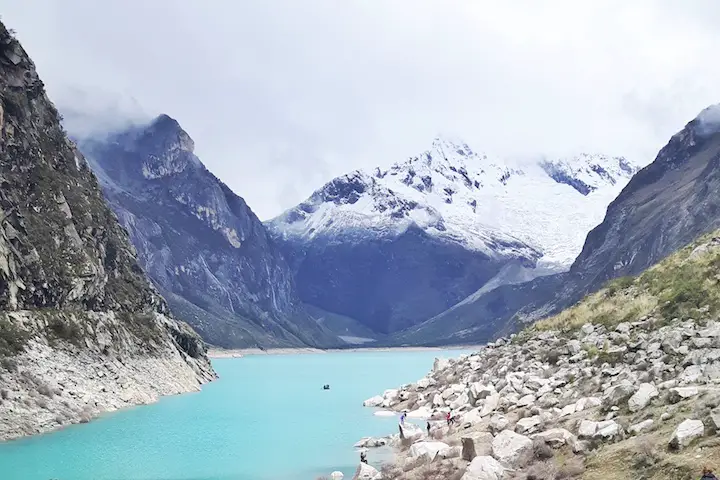
READ THIS POST:
An Adventure-packed 2-Week Peru Itinerary
San Cristobal Island Guide
San Cristobal is the second most populated, and visited, island in the Galapagos archipelago. The main town of Puerto Baquerizo Moreno is actually the administrative capital of the Galapagos. The town feels a little classier somehow and has a lovely waterfront promenade that is a great place to wander in the evenings.
San Cristobal feels more ‘natural’ than Santa Cruz and, while there aren’t perhaps as many independent things to do, you will feel have more opportunities to get up close and personal with the local wildlife.
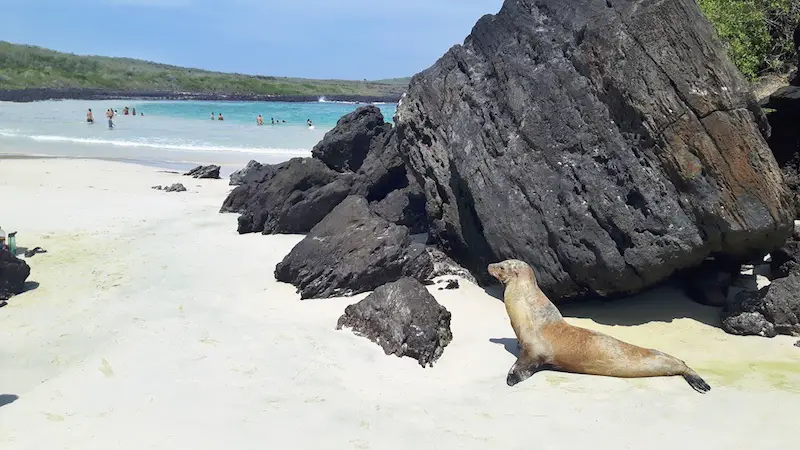
How to Get to Isla San Cristobal
Daily flights arrive at San Cristobal Airport bringing visitors from either Quito or Guayaquil on the mainland. Unlike Baltra Airport, this one is just on the edge of the main town, Puerto Baquerizo Moreno. It’s an easy 10-20 minutes walk, depending where your accommodation is or a taxi won’t cost more than a few dollars.
For those coming from other islands, speedboat ferries arrive twice a day from Santa Cruz Island. Departures are scheduled to leave Santa Cruz for San Cristobal at 7am and 2pm and take approximately two hours.
The Best Activities in San Cristobal
We have a detailed guide for San Cristobal Island but here are a few of our favourite activities:
- Hang out with the local sea lion population: San Cristobal has the largest sea lion population of all the islands. They are literally everywhere and so fun to just sit on a bench and watch them.
- Book the 360º Tour: If we could recommend just one thing for your entire Galapagos excursion, this would be it.
- Hike to Cerro Tijeretas, Darwin’s Cove and Punta Carola: These three can easily be combined and together provide amazing views, great snorkelling and loads of wildlife sighting opportunities.
- La Lobería Beach: Named for the sea lions that love it, this is also a beautiful beach. The snorkelling is great here too as there is an outer reef protecting the shallows. Sea lions and turtles are very common here.
- The Interpretation Centre: This was probably the most interesting of all the islands. Take some time to see and read the exhibits.
Where to Stay in San Cristobal
An excellent budget option is Casa de Jeimy. We stayed here on our second visit and enjoyed the ocean views from the rooftop terrace and made good use of the 3 shared kitchens available for guests. We even had a piece of an ocean view from our room’s balcony and the location is ideal. Check out their prices and availability now.
For a little more luxury and comfort, Galapagos Sunset Hotel is unmatched. The ocean views are out of this world and there is an included breakfast. Guests rave about the service and cleanliness while the location, right on the malecon, cannot be beaten. Check out the pictures and reviews now.
Tips for San Cristobal
- Rosita’s is a great restaurant for a budget meal in a nice setting. They have a set menu for $6-7 that includes soup, main course, dessert and juice. Just check it’s available before you sit down, during our second visit they didn’t have it that day.
- Lucky’s is well-known as one of the best spots for good, cheap food so it’s perfect for those travelling to the Galapagos on a budget.
- At least once, have a sunset drink at Nativo. Situated right on the water’s edge beside Playa de Oro, you will have a wonderful view of both the sunset and the hundreds of sea lions who crowd the beach in the evening.
Guide to Isla Isabela
Isla Isabela is the largest yet least populated island, at least in terms of humans. Isabela Island has the largest biodiversity of all islands and is a favourite with everyone who visits. The sandy streets of the one small town, Puerto Villamil and the palm-tree lined beach give it the most tropical feel of all the islands.
There are fewer choices when it comes to independent activities, accommodations and dining, but what is available more than makes up for that!
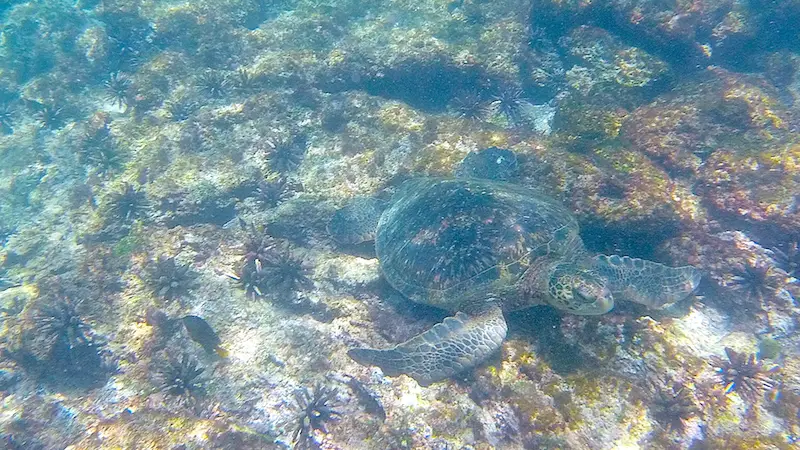
How to Get to Isla Isabela
To reach Isabela Island (without a cruise) you will need to take a speedboat ferry from Santa Cruz Island. Boats leave Santa Cruz to Isabela at 7am and 2pm daily. Book your tickets a day or two in advance and shop around a little. There was some flexibility in the price of this route.
The Best Activities in Isla Isabela
You can find our detailed Guide to Isla Isabela for more information but here is a quick rundown of our top recommendations:
- Los Tuneles day tour: This is generally considered to be one of the best day tours in all of the Galapagos. From walking through bizarre landscapes to snorkelling with a long list of marine life, this is worth the hefty price tag.
- Las Tintoreras half-day tour: Quite similar to Los Tuneles, Las Tintoreras are much closer to town so it’s a shorter tour. You can expect to see much of the same wildlife as on Los Tuneles but perhaps less variety. The big bonus here is that this is one of the best spots to see Galapagos penguins.
- Concha de Perla: Free snorkelling with a very good chance of encountering sea lions, turtles, penguins and plenty of fish – this is a must-do activity in Isla Isabela. We actually saw more marine activity at the small dock beside the ferry dock but snorkelling it’s not so great for snorkelling.
- Playa Puerto Villamil: The beach is stunning, over 3km long and starts right in town. The only downside we can think of is a lack of shade so make sure you pack your sunhat and sunscreen. It’s a popular place to watch the sunset and for good reason.
- The trail to the Wall of Tears: While we weren’t overly impressed with the actual wall, the trail is well worth the time. It takes you past flamingo lagoons, small beaches, a lava tunnel and through a semi-natural giant tortoise habitat. We would highly recommend renting bikes rather than hiking.
Where to Stay in Isla Isabela
We stayed at Hostal Jeniffer. It was clean, comfortable and incredibly friendly. The shared kitchen was well-stocked and the outdoor seating area was the perfect place to eat our meals. It is a short walk away from the main street in town and the beach. Hostal Jeniffer is only available to book on AirBnB. If you are new to AirBnB, use this link to get $45 CDN off your first booking.
Looking to splurge on your once-in-a-lifetime trip? Check out the stunning Iguana Crossing Boutique Hotel. With modern, clean and comfortable rooms and an included breakfast buffet, this is a great option. However, the infinity pool and terrace overlooking the ocean are really what make this place special. Technically it is across the road from the beach but the sandy street sees little more traffic than tourists on rental bikes and the occasional pick-up truck heading to the nearby tortoise breeding centre. Check out the pictures and reviews now.
Tips for Isla Isabela
- This is the best island to splurge on an oceanfront room.
- Bring some snacks and groceries with you from Santa Cruz. The options are extremely limited in Isabela and budget eating options are almost non-existent.
- Bring enough cash. As of 2019, there is now an ATM on Isabela Island (you will read everywhere that there isn’t). However, we weren’t expecting it and brought enough cash so I can’t say how reliable it is. It is across the street from Galapagos Bike & Surf on Escalesias.
- Don’t choose the kayak tour for Las Tintoreras (unless you really want to). I planned to book the kayak tour as it sounded like more fun. However, we were told that it only covers a small portion of the area that the boat tour does. The hike is shorter and the snorkel is not in as good a location.
Floreana Island Guide
Floreana has the smallest human population (around 100) and receives far fewer independent visitors. We didn’t make it to Floreana during our time in the Galapagos but it is best visited if you have an interest in the human history of the islands. With pirates, whalers and possible murders, it certainly boasts the most interesting history of all the islands.
Aside from cruises, many of which stop at Floreana Island, day tours are the most popular method of visiting the island. Few visitors make the effort to go independently and stay overnight, but for those that do, it can be very rewarding.

How to Get to Floreana Island
There is a (sort of) daily ferry that leaves Santa Cruz at 8am. However, be sure to check ahead as this is generally combined with a day tour and will only run when there are enough people. Talk to your accommodation host on Floreana (definitely book ahead) and they will help you confirm and adjust your reservation if necessary.
The Best Activities in Floreana
- Devil’s Crown: This is supposed to be one of the top snorkel sites in the Galapagos Islands. The volcanic crater is filled with coral reefs teeming with marine life while the rocky ledges are a favourite place to rest for many sea birds.
- Post Office Bay: Probably the most famous feature on Isla Floreana is the barrel used as the first post office by whalers in 1793. Take a postcard with you to ‘mail’ and be sure to take any with you with an address close enough to your home that you can deliver it.
- Pirates’ Caves: The island was also a popular refuge for pirates who used to hide in the caves. Take a chiva bus into the highlands.
- Star-gazing at night: Due to the lack of light population, the stars are brilliant at night. Take the time to sit outside and look up.
Where to Stay in Floreana Island
Accommodation choices are limited but the Floreana Lava Lodge is an excellent choice. Boasting ten beachfront cabins and an included full breakfast, guests have great things to say about this place. Check the availability now.
Black Beach House is a great alternative. Slightly cheaper, it also comes with a shared kitchen and a beachfront location. It is owned by one of the first families to inhabit the island in the 1930s. Check prices and reviews now.
Tips for Floreana Island
- Bring snacks. There is no convenience store on the island.
- With only a few restaurants, it is important to arrange meals ahead of time. Either talk to the restaurant directly or ask your accommodation to help make reservations.
- Read the books and watch the movie “The Galapagos Affair” before you arrive to give some background information for the history of the island.
For more detailed information on how to plan a trip to the Galapagos Islands without a cruise, get our Perfect Galapagos Packing List and read our detailed island and activity guides below:
- 16 Amazing Things to do in Santa Cruz (mostly free)!
- 17 Unforgettable Things to do in San Cristobal.
- 11 Reasons you should visit Isla Isabela.
Does vacation planning make your head spin? We’ve got you a covered with a ready-to-book two-week land-based itinerary.
[space_20]
If you found this guide helpful, please pin it for safekeeping!
[columns] [span6]
[/span6][span6]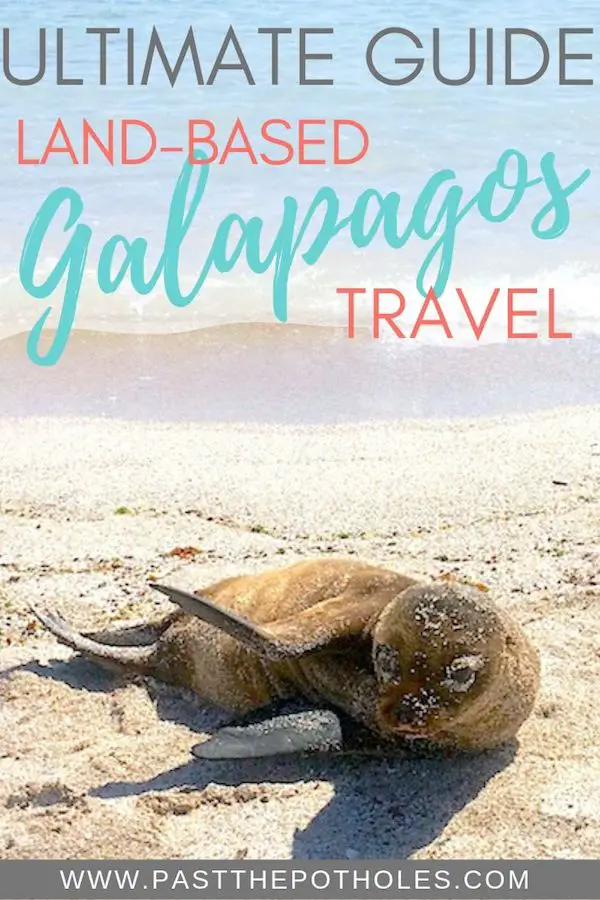
[/span6][/columns]
Find all our Ecuador posts in one place here.
Get more travel inspiration on our Destinations page.
Ready to book? Use our favourite travel websites to save time and money.
